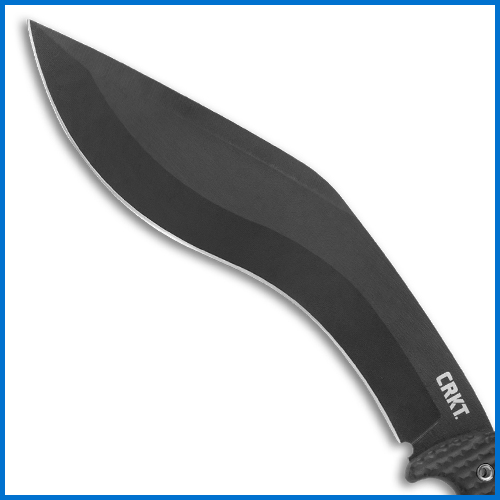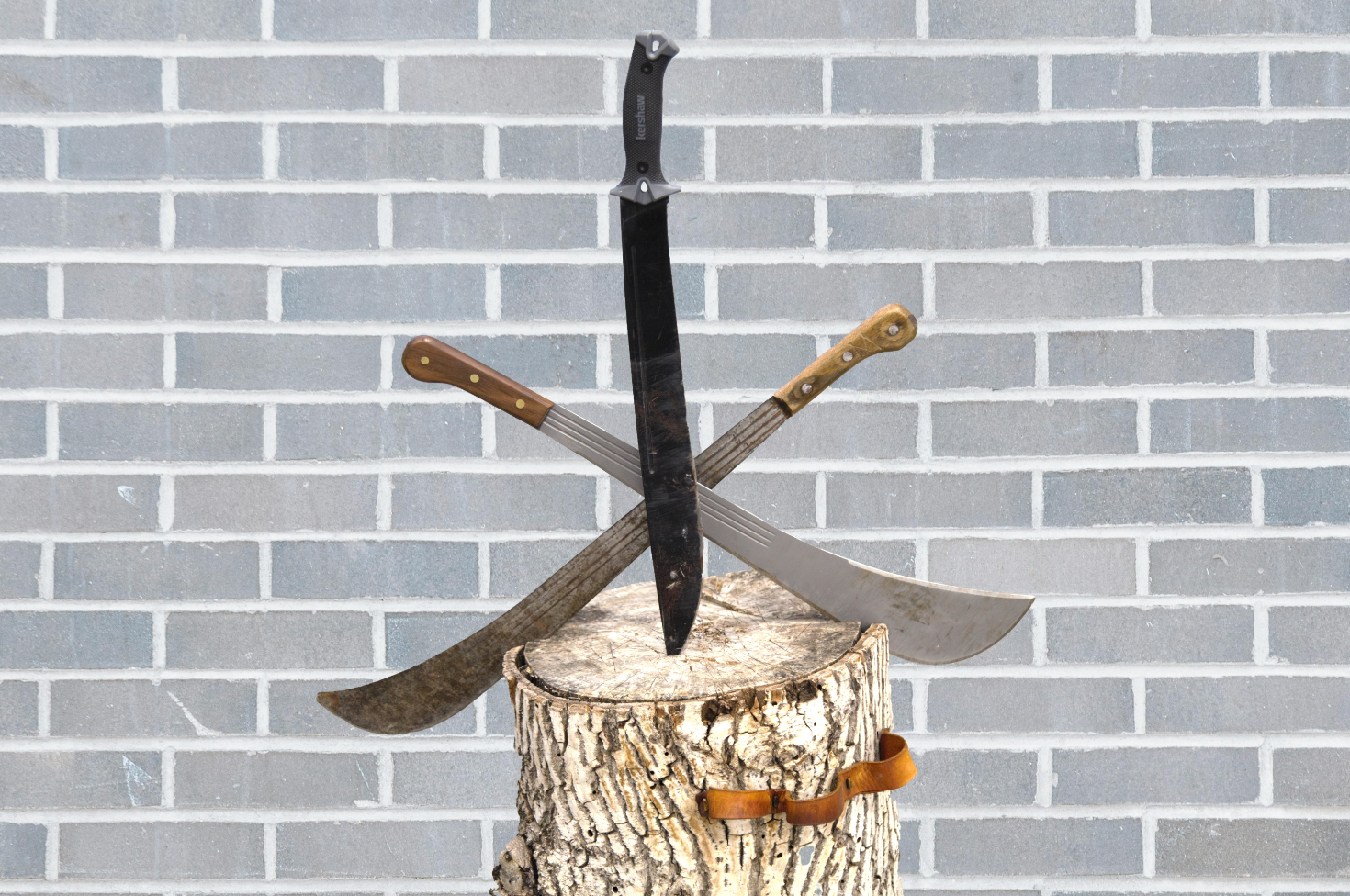
You’re ready to buy your next pocket knife. You’ve been thinking about the blade steel, handle material, lock type, opening mechanism, all while making sure your knife strikes that perfect balance between badass and practical. But there’s one crucial aspect that you may be overlooking: Blade shape. The blade is the soul of the knife; it influences how the knife is best used. From a classic clip point to the unconventional hawksbill, there are many blade shapes out there to choose from and each one has its unique strengths.
In this blog post, we’ll take a deep dive into 16 of the major blade shapes, exploring their characteristics and best uses. By the end of this post, you’ll have a better understanding of how blade shape factors into a knife’s performance and be equipped with the knowledge to choose the perfect blade for your needs. So, let’s get to the point(s) and find the right blade for you.

1. Drop Point
Popularized by renowned American knifemaker Bob Loveless, the drop point is easily the most common and popular blade shape in modern designs. It’s called a drop point because as the spine of the blade comes out of the handle, it slopes down (or “drops” if you will) into the tip of the knife.
The gradual downward slope of the spine creates an easily controlled point, which increases your blade’s precision. Drop point blades feature a wide belly with a long continuous edge that really excels at slicing and cutting. The broader shape of the tip prevents breaking, adding to the drop point’s versatility.

2. Clip Point
The clip point blade, also known as a Bowie knife, is characterized by a spine that comes straight off the handle before abruptly swooping down to a fine point — almost as if part of the blade has been clipped off. The clip point’s tip is thin and sharp, making it great for piercing objects and fine detail work. Because of the thin construction of the clip point blade, its tip can be significantly weaker than other blade types. This blade style has been popular among American outdoorsmen and hunters for decades proving itself to be a reliable blade suitable for a wide range of tasks.

3. Spear Point
Spear point blades are symmetrical with a point in line with the center of the knife. Their symmetry and balance make them ideal for stabbing and thrusting. It’s common for spear point blades and dagger blades to be used interchangeably, and it can be tricky to distinguish the line between spear point and dagger. The easiest and simplest distinction is that the top edge of the spear point blade is not sharp.
There are a couple of varieties of spear point blades that have become popular in recent years that are worth mentioning. The bayonet style blade is an iteration of a spear point blade. It has the same symmetry of a spear point, but only two thirds of the top edge are sharp. The pen knife blade style shares the symmetry of the spear point but features a more gradual curve. Pen blades are typically found on smaller folding knives, specifically traditional pocket knives.
4. Dagger
The dagger blade is the more aggressive sibling of the spear point blade. Dagger blades feature the same symmetry and balance as spear point blades, built for stabbing and thrusting. Characterized by two sharpened edges, dagger blades are popular among tactical knives.
Dagger knives are designed and built to be stabbing weapons, and they don’t have a lot of practical uses beyond that. As badass as they look, they don’t make the best everyday carry knives. It’s worth noting that daggers must be open carried and cannot be concealed in the state of California. Make sure you’ve checked your state’s laws before committing to a dagger shaped blade for your next pocket knife.

5. Tanto
Inspired by the short swords worn by the samurai of feudal Japan, the tanto blade forgoes a curved belly for an angular edge. The blade’s characteristic angled point creates a remarkably strong tip, making tanto blades adept at piercing and prying. The strength of the tanto blade along with its unique shape has made tanto blades incredibly popular among EDC pocket knives. The angled tip of the tanto isn’t without its downsides. The abrupt angle in the blade does reduce its slicing capabilities, and sharpening a tanto blade is more involved than other curved blades.
6. Reverse Tanto
As the name suggests, the reverse tanto blade is the mirror image of its twin brother. The reverse tanto blade features a straight spine that angles downward towards the tip. Like the tanto, the construction of the reverse tanto is reinforced with more steel — making it tougher and harder to break.
With the distinctive angle on the top of the blade instead of the belly, the reverse tanto is better at slicing than the tanto without sacrificing its strong tip and piercing ability.
Shop Reverse Tanto Blade Knives

7. Wharncliffe
he Wharncliffe style blade was originally designed for whittling and other EDC tasks that favored slicing and cutting more than stabbing and piercing. Wharncliffe blades are typically known to be relatively short, exceptionally thick, and remarkably sturdy. Tracing its name back to Lord Wharncliffe, a 19th century knife factory proprietor. It was designed to be a broad, tough blade that could stand up to a lot of stress and strain.
Wharncliffe blades are well suited to rough carving and slicing. Its fine point is well suited to delicate detail work, making precision cuts easier.

8. Sheepsfoot
You could make a strong argument that the sheepsfoot blade is the best shape for work. With a nearly blunted tip to avoid puncturing, the sheepsfoot knife was first used by shepherds to trim the hooves of sheep. Today, it’s common to see sheepsfoot blades used by first responders, river guides, and warehouse workers who need to make cuts without accidentally cutting people, rafts, or products.

9. Standard (AKA Straight Back)
Sometimes called a “straight back” to make it seem less boring, the standard style blade has a straight spine and a traditional belly. Even if the shape isn’t particularly exciting, sometimes simplicity is the best option. Because the standard blade isn’t specialized towards any one purpose, it’s able to do just about anything. Remember, knives have been around for hundreds of thousands of years — there’s a reason that this shape is considered to be standard.
Shop Standard and Straight Back Knife Blades

10. Trailing Point
The spine of a trailing point blade comes straight out of the handle before trailing up, leaving the tip as the highest point of the blade. The benefit of a raised tip is that the knife has a large, curved belly that is ideal for skinning and slicing. They also offer the sharpest tip for the fine and delicate work you’ll encounter when processing fish and game. Naturally, trailing point blades are very popular among hunters and fishermen.
Because this blade is designed for delicate precision work, these knives tend to be thin and therefore susceptible to bending or breaking when used on tougher materials.
Shop Trailing Point Blade Knives

11. Hawksbill
The hawksbill blade (sometimes called the hawkbill blade) is the opposite of the trailing point blade. The blade hooks downward making a wicked talon-like blade. Hawksbill blades are most common on karambit knives. Even though they’re primarily used as a tactical and self-defense tool now, the hawksbill blade was initially developed as a utility knife and farming tool in Malaysia and the Philippines during the 11th century. Outside of tactical applications, a hawksbill blade is useful for cutting cords, stripping wires, pruning plants, and cutting carpet.
12. Cleaver
Just like the coolest looking knife in your kitchen, a cleaver blade on a pocket knife excels at chopping and slicing. Built for repeated blows into dense meat and bone, cleaver blades tend to make exceptionally durable EDC options. While not a great option for piercing or stabbing, a cleaver blade is great at slicing everything from rope to food to cardboard and anything else you come across.
13. Harpoon
The harpoon point blade is built much like a drop point blade, with a spine that gently slopes down into the point leaving a wide belly for slicing. The harpoon point shares all the strengths and advantages of the drop point blade, with an additional feature on the blade’s spine. Harpoon point blades are marked by an upward ramp on the spine that resembles the barbs on whaling harpoons — hence the name. The ramp provides an extra bit of leverage and control when you place your thumb on the ramp.

14. Kukri
Easily one of the most recognizable and distinctive blade shapes, the Kukri blade can trace its origins back to Alexander the Great’s campaigns in modern day India. Widely believed to be an adaptation of the Greek Kopis, the Kukri has traditionally been used as a basic utility knife by Nepali-speaking Gurkhas. The Kukri has become the signature weapon of Gurkha soldiers for centuries. The Kukri’s characteristic curved shape creates a wedge effect, causing the blade to cut effectively and deeper.
15. Kriss (Reverse “S”)
The Kris knife is an asymmetrical dagger that originated in Indonesia that has traditionally served as both a weapon and a spiritual object. Kris blades are usually narrow with a wide, asymmetrical base that continues into a waving blade. As an EDC option, the wavy blade is more decorative and ceremonial than it is versatile and reliable.
16. Gut Hook
The Gut hook Blade undoubtedly has the meanest sounding name of all the blade shapes and was built specifically for hunting and field dressing. The gut hook blade looks like a drop point with a wide belly good for slicing. The distinctive sharpened hook behind the tip of the blade is designed to open the insides of an animal without damaging the muscle. While most gut hook blades are found on fixed blade knives, you can find the occasional folding knife version.
Blade Style Variations & Other Fun Stuff

Recurve Blades
A recurve blade is more a feature of a blade type rather than a blade type in and of itself. For example, you might call a Kukri a recurve blade because of the concave portion of the knife. At the same time, it’s common to find drop point and trailing point knives with recurves in their blades.
Modified Blades
Modified blade shapes are another popular trend in the world of knives, with many artisans and bladesmiths experimenting with variations on classic blade styles to create new and unique designs. These modified blade shapes may include alterations to the tip, edge, or spine of the blade. These variations of existing styles don’t necessarily constitute their own blade shape but can be categorized as modified versions of existing shapes.
Learn More
The video below highlights many of the different grinds and steels you can find on knives today. Different grinds can be found with different blade shapes, so keep both in mind and pick the one that suits your fancy.
Other Best Knife Guides
Still in that information gathering phase? We’ve got a bunch more guides on many different topics! Happy hunting and may you find that one special knife of your dreams.




